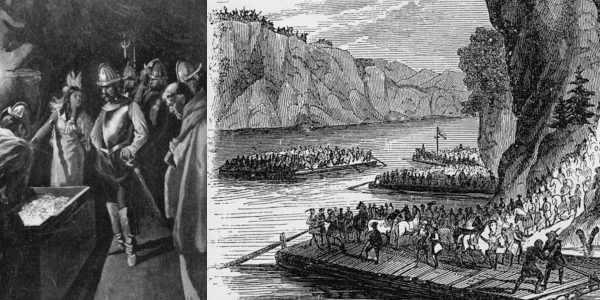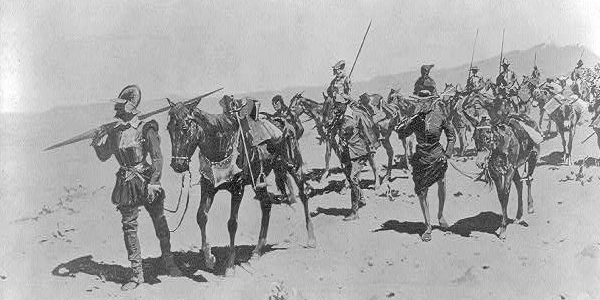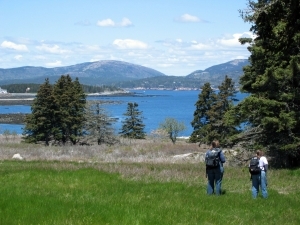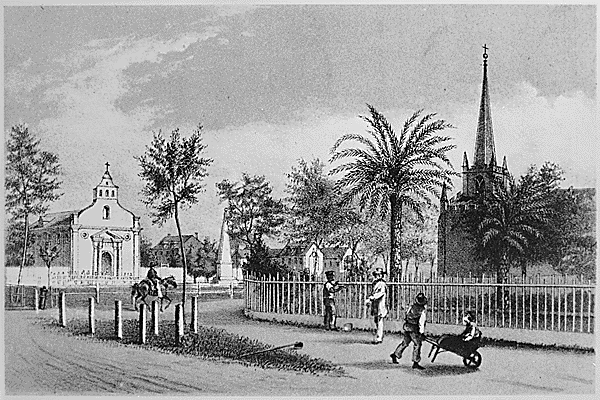Sponsor this page. Your banner or text ad can fill the space above.
Click here to Sponsor the page and how to reserve your ad.
-
Timeline
Detail - 1540
March 3, 1540 - The de Soto expedition continues into Georgia in search for gold and a passage west. He would proceed into the mountains of North Carolina and Tennessee. An ambush in northern Alabama, which may have been precipitated by actions of the expedition, by the Mabilian Indian tribe, resulted in twenty Spanish explorer deaths and the demise of thousands of Indian warriors. De Soto burned the city. He would later winter near Tupelo, Mississippi.

On May 25, 1539, Hernando de Soto and his expedition of nine (seven to ten) ships, including the flagship San Cristobal, over six hundred and twenty volunteers (some sources contend upwards of seven hundred to one thousand, but the number around six hundred seems most likely), and two hundred and twenty horses sighted the southern part of Tampa Bay, disembarking five days later as part of his mission for the King of Spain to colonize and explore Florida and the lands of America as its Governor. For the remainder of that year, the expedition explored the northern part of Florida before camping for the winter with the Apalachee tribe at their capital city Anhaica.
As spring approached, the expedition readied to trek north into today's Georgia. Their goal, as others had been directed by all European powers, was to find minerals, gold, and that elusive waterway that would take them west to the Orient. They camped for two days, March 17-18 at the site of Mineral Spring, today's Alligator Spring near Arlington, Georgia after a small confrontation with the tribe in Capachequi the week before. On March 23, 1540, they reached the large village of Toa.
The expedition continued north, crossing the Savannah River on May 1, 1540 before meeting with the Lady of Cofitachequi, chief of that village along the east bank of the Santee (Congaree) in South Carolina. It is thought that she headed a tribe of the Kasihta, i.e. part of the Muskogee. She greeted them amicably and handed the soldiers pearls (200-350 pounds) and food, but no true gold. Finding no gold there, de Soto headed into the mountains of North Carolina, passing the Little Tennessee River at Franklin, to rest his horses and search for the gold long rumored. He found none there either, but became the first European to cross a tributary of the Mississipi River.
By June 4, 1540, the expedition marched past Lookout Mountain, in today's Chattanooga, Tennessee. They explored the territory of the Catawba towns, Chiaha towns, as well as Coosa (north of today's Childersburg), the Coosa River, and Coste. By August 20, the expedition left the villages of the Coca Indians, taking the Indian chief with them before arriving at Itaba, a large Indian village where they bought some Indian women in exchange for glasses and knives. On September 6, they reached the area of Montgomery, Alabama. The weather of the spring and summer had been dry, with little rain. There had been minor skirmishes with various tribes and the expedition began capturing and/or purchasing Indian men and women along their journey in exchange for goods, or for pique. They arrived at Talisi and were confronted by messengers of the chief at Tascaluca, who was powerful and feared. In October, de Soto sent his second in command, Master of the Camp, Luis de Moscoso, with fifteen cavalry to the village of the Tascaluca chief; he got assurances that they would be welcome. Hernando de Soto met with Tascaluca, the Indian chief, on October 10, 1540.
The Battle of Mabila
Although the meeting with Tascaluca had seemed to go well, the custom of de Soto was to take the chief with them, in custody, for several days. Tascaluca had promised them a hundred women upon the expedition reaching Mabila on the far reach of his territory. As they approached Piachi, a village on the way to Mabila, their chief refused passage, killing two Christians. There had been bad tiding from that village toward the Spanish before; Don Teodoro and a servant who had been with the Narvaez expedition had been killed by them. On October 16, the two messengers who had been sent forward to Mabila by de Soto arrived back with news of that village. It was well armed, with many warriors, and fenced in.
It is unknown whether a confrontation prior to them reaching Mabila, where a Spaniard went missing, may have prompted the coming fight, or whether Tascaluca had planned the coup prior to them reaching Mabila, but when the expedition reached Mabila on October 18, 1540, the warriors of the province had been assembled. De Soto approached the stockaded town accompanied by forty to two hundred horsemen and foot soldiers, (sources vary as to the number). Only a portion entered with Hernando de Soto and Tascaluca, who left a ceremony in the town square just as de Soto and his troups rose to leave, which the Indians attempted to prevent. The soldiers escaped, but left behind were some Christian women, a friar, and a few others. Some sources contend that five of them were killed instantly.
Outside the stockade, more Spanish soldiers arrived to free those captured; the battle lasted all day. Twenty (up to 102) Spanish soldiers were killed during the Battle of Mabila; two thousand five hundred to eleven thousand Indian warriors were estimated among their casualties, although chief Tascaluca escaped. The town was destroyed.
The expedition remained near the destroyed town until November 12; an intended rendezvous with Spanish ships at the port of Achuse was cancelled amid talk of desertion. Instead, de Soto ordered the expedition to head inland. As the expedition passed into the territory of Mississippi, they crossed the Tombigbee River at the town of Chicasa, a Chickasaw village, a tributary of the Alabama River, on December 14 (16), 1540. The expedition would spend the winter twenty miles west of Tupelo and south of today's town of Pontotoc.
It would be another year before Hernando de Soto would get his chance at becoming the first European to see the waters of the broad expanse of the Mississippi River.

Primary Source Quotes
"She (Lady of Cofitachequi) crossed in the canoes and spoke to the Governor quite gracefully and at her ease. She was a young girl of fine bearing; and she took off a string of pearls which she wore on her neck, and put it on the Governor as a necklace to show her favor and to gain his good will. And all the army crossed over in canoes and they received many presents of skins well tanned and blankets, all very good; and countless strips of venison and dry wafers, and an abundance of very good salt. All of the Indians went clothed down to their feet with very fine skins well dressed, and blankets of the country, and blankets of sable fur and others of the skin of wild cats which gave out a strong smell. The people are very clean and polite and naturally well conditioned," Rodrigo Ranjel, May 1, 1540.
"Sunday, October 10, the Governor entered the village of Tascaluca, which is called Athahachi, a recent village. And the chief was on a kind of balcony on a mound at one side of the square, his head covered by a kind of coif like the almaizal, so that his head-dress was like a Moor's which gave him an aspect of authority; he also wore a pelote or mantle of feathers down to his feet, very imposing; he was seated on some high cushions, and many of the principal men among his Indians were with him. He was as tall as that Tony of the Emperor, our lord's guard, and well proportioned, a fine and comely figure of a man. He had a son, a young man as tall as himself but more slender. Before this chief there stood always an Indian of graceful mien holding a parasol on a handle something like a round and very large fly fan, with a cross similar to that of the Knights of the Order of St. John of Rhodes, in the middle of a black field, and the cross was white. And although the Governor entered the plaza and alighted from his horse and went up to him, he did not rise, but remained passive in perfect composure and as if he had been a king. The Governor remained seated with him a short time, and after a little he arose and said that they would come to eat, and he took him with him and the Indians came to dance; and they danced very well in the fashion of rustics in Spain, so that it was pleasant to see them. At night he desired to go, and the commander told him that he must sleep here,..." Rodrigo Ranjel, October 10, 1540.
"As soon as the battle line and rear guard reached Mavilla (Mabila), the governor ordered all those who were best armed to dismount and made four companies of foot. The Indians, on seeing how the governor was drawing up his men, urged the cacique (chief Tascaluca) to leave, telling him, as was later learned from some Indian women who were captured there, that he was only one man and could fight for one only; that there were many principal men of the Indians there, very daring and skillful in matters of war, any of whom could direct all the other men; that since matters of war and victory were a hazard of fortune and there was no certainty as to which of the sides would be victorious, he should endeavor to place his person in safety, so that if they should end their lives there, as they had resolved to do rather than allow themselves to be vanquished, he would be left to govern the land. However, he refused to go, but so much did they urge him that he went out of the town with twenty or thirty of his Indians," Juan Ortiz Elvas, October 18, 1840.
Image above: Montage (left) drawing of Hernando de Soto visiting the chieftess of the Cofachiqui village, in today's South Carolina, 1898, George Gibbs; (right) drawing of the de Soto expedition crossing the Tombigbee River in Alabama, 1858, John William Orr. Both courtesy Library of Congress. Image below: Map of the Hernando de Soto expedition, 2008, Herb Roe. Courtesy Wikipedia Commons. Source info: Wikipedia; Final Report of the United States De Soto Expedition Commission in 1939; De Soto National Trail Study, 1988, National Park Service; "True Relation of the Hardships Suffered by Governor Fernando de Soto and certain Portuguese Gentleman During the Discovery of the Province of Florida, Gentleman of Elvas," Juan Ortiz Elvas, 1557/1609, floridahistory.com; "The Inca," 1605, Garcilaso de la Vega; Diary of Rodrigo Ranjel, de Soto secretary, La Historia general y natural de las Indias, Gonzalo Fernándex de Oviedo y Valdés, 1851/1904; Report by Luys Hernández de Biedma, 1544/1851.





